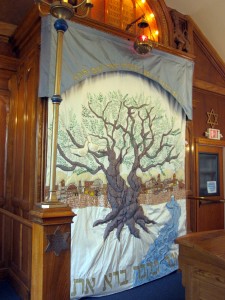
Designed by congregant Dianne Saxe and embroidered by Israeli-Canadian artist Tova Raz, the synagogue’s ark curtain draws on traditional symbols of Jewish life to emphasize the high value the congregation places on gender egalitarianism. The Book of Psalms inspires the central imagery, in which a tree planted by flowing water symbolizes how a Torah-centred life gives a pious Jew the strength to flourish. In the curtain, the intertwining trunks of the tree represent the interwoven male and female aspects of the congregation.
History reflects growth and development of Toronto’s Jewish population
By Annemarie Brissenden
In May 1914, with the world on the brink of war, 13 men formed an association to provide social benefits such as medical care and religious customs to all those sharing a link to the same small village in Eastern Europe. Today, that association is a thriving 680-member congregation based out of a synagogue on Brunswick Avenue. And while it developed along a well-worn path that echoes the growth of the city it now calls home, the First Narayever Congregation has evolved into a unique model of traditional egalitarianism that meets the needs of both its religious and broader downtown communities.
“I could have predicted the story: the Jewish community’s moves around the city; its part in the post-war boom; the return of people to the Annex; and the revival of downtown Jewish life, anchored in part by the Narayever,” said Sharoni Sibony, the curator of Traditions and Transitions: 100 Years of the First Narayever Congregation, an exhibit that ran throughout October at the Miles Nadal Jewish Community Centre in conjunction with the synagogue’s centennial celebrations.
“First Narayever starts as a typical, immigrant working class synagogue,” explained Sibony, meeting in the homes of its members, before renting a space at Huron and Dundas streets for approximately 20 years.
By 1943, the congregation had raised enough money to purchase its current home, a building at 187-89 Brunswick Ave., previously a Foresters’ Hall and home to Bethel Church, the first English-speaking Mennonite congregation in Toronto.
Although “the downtown area was the original hub of Toronto’s Jewish community, many people left the neighbourhood [starting in the 1950s] and moved north,” said Harry Schacter, First Narayever’s president.
“There was a severe decline in the Jewish population in downtown Toronto,” added Rabbi Edward Elkin, the congregation’s spiritual leader since 2000. “Lots of little immigrant synagogues closed altogether. Ours was teetering, and hung on until the renaissance in the 1970s.”
That renaissance precipitated an ideological shift that made First Narayever into the congregation it is today: moving from an orthodox practice to a traditional-egalitarian one in which women would play an equal role in the service and running of the congregation.
“This made us unique at the time,” explained Elkin. “We were holding on to all of the traditional observances and trappings, while being egalitarian.”
Sibony said that one of the things that really struck her as she prepared the exhibit on the congregation’s history was “how much the early egalitarian activists seemed to value orthodoxy.”
And the question of how to make women’s participation full and inclusive in a traditional setting is “a conversation that is very much alive 35 years later,” she said.
“It was a very dramatic shift at the time,” said Schachter, adding that it also made the synagogue more participatory. “It did much to involve ordinary people in the running of the service.”
Sibony also suggested that the move to egalitarianism created a less hierarchical structure in the running of the congregation, and explained how the building itself facilitated this evolution.
“The closeness of the podium area and audience area feels rare to me. The smallness of the building facilitates that closeness, and really empowers the people,” she said.
The combination of traditionalism and egalitarianism has proven successful at attracting those people who are returning to the neighbourhood and choosing to live downtown.
“All of these people coming in, because of our ideological decision, we were ripe for some of those people,” said Elkin.
“We have become a home for newcomers looking for a new place for themselves,” added Schachter, noting, “the population is continuing to grow around us.”
Although it has shifted ideologically, it has remained true to its social justice roots, as it continues to evolve in its egalitarianism.
“In 2009 we voted to extend same-sex marriage as a principle of the synagogue, which is also a rarity,” said Sibony. The congregation also continues to serve its members and the surrounding community by participating in a local Out of the Cold program with other faith-based institutions, sponsoring refugees, and developing sustainable, local, and affordable food choices.
As the congregation contemplates the next one hundred years, said Schacter, “we have to think about where we are going. We have to continue to think about our place in the downtown Jewish community, and the broader community as a whole.”
“We feel quite rooted in the Annex,” said Elkin. “We have to continue to be good neighbours and citizens of a downtown community where a lot of diverse people continue to thrive and live.”
